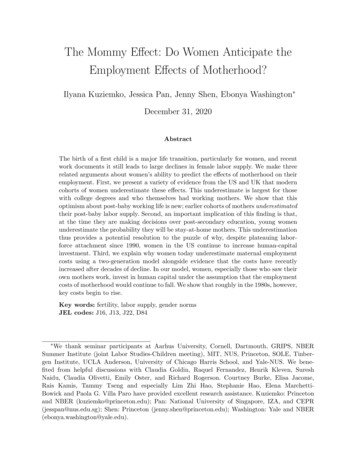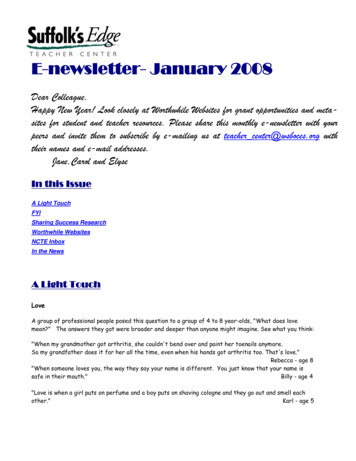
Transcription
The Mommy Effect: Do Women Anticipate theEmployment Effects of Motherhood?Ilyana Kuziemko, Jessica Pan, Jenny Shen, Ebonya Washington December 31, 2020AbstractThe birth of a first child is a major life transition, particularly for women, and recentwork documents it still leads to large declines in female labor supply. We make threerelated arguments about women’s ability to predict the effects of motherhood on theiremployment. First, we present a variety of evidence from the US and UK that moderncohorts of women underestimate these effects. This underestimate is largest for thosewith college degrees and who themselves had working mothers. We show that thisoptimism about post-baby working life is new; earlier cohorts of mothers underestimatedtheir post-baby labor supply. Second, an important implication of this finding is that,at the time they are making decisions over post-secondary education, young womenunderestimate the probability they will be stay-at-home mothers. This underestimationthus provides a potential resolution to the puzzle of why, despite plateauing laborforce attachment since 1990, women in the US continue to increase human-capitalinvestment. Third, we explain why women today underestimate maternal employmentcosts using a two-generation model alongside evidence that the costs have recentlyincreased after decades of decline. In our model, women, especially those who saw theirown mothers work, invest in human capital under the assumption that the employmentcosts of motherhood would continue to fall. We show that roughly in the 1980s, however,key costs begin to rise.Key words: fertility, labor supply, gender normsJEL codes: J16, J13, J22, D84 Wethank seminar participants at Aarhus University, Cornell, Dartmouth, GRIPS, NBERSummer Institute (joint Labor Studies-Children meeting), MIT, NUS, Princeton, SOLE, Tinbergen Institute, UCLA Anderson, University of Chicago Harris School, and Yale-NUS. We benefited from helpful discussions with Claudia Goldin, Raquel Fernandez, Henrik Kleven, SureshNaidu, Claudia Olivetti, Emily Oster, and Richard Rogerson. Courtney Burke, Elisa Jacome,Rais Kamis, Tammy Tseng and especially Lim Zhi Hao, Stephanie Hao, Elena MarchettiBowick and Paola G. Villa Paro have provided excellent research assistance. Kuziemko: Princetonand NBER (kuziemko@princeton.edu); Pan: National University of Singapore, IZA, and CEPR(jesspan@nus.edu.sg); Shen: Princeton (jenny.shen@princeton.edu); Washington: Yale and NBER(ebonya.washington@yale.edu).
1IntroductionThe birth of a first child is a major life transition. It is arguably more significant thanretirement, marriage or any educational milestone, especially for women. Motherhood is atonce incredibly common (even at low points throughout U.S. history, generally more thaneighty percent of women eventually give birth to at least one child) and yet difficult toenvision ex ante (the titles of a popular series of pregnancy and parenting books all beginwith the words “What to expect. . . ”).Maternal labor supply is likely to be a particularly difficult aspect of motherhood foryoung women to forecast. While the vast majority of women in the US and other richcountries work before motherhood (and have done so for decades), the labor supply of mothershas changed dramatically over time. In the US, it rose rapidly between 1960 and 1980. It hassince plateaued and in fact slightly decreased since 1990 (we show these trends in AppendixFigure A.1, along with those from several other rich countries). Moreover, whether a motherworks while her children are young remains a controversial subject.1 While there is a richliterature in economics assessing whether individuals and households prepare sufficiently forretirement, there is little work examining whether they form correct expectations aboutparenthood or exploring the implications of mistaken expectations thereof.In this paper, we make three related arguments about women’s ability to anticipate theemployment costs of motherhood, which we define as the time, effort or money required formothers to raise their children in a manner they deem appropriate, while also working outsidethe home. Examples of these costs might include the emotional cost of being separated fromthe child while at work, the per-hour cost of a nanny or day-care service, guilt over (perceivedor real) underperformance as an employee or mother, or diminished sleep or other aspectsof wellbeing due to working while also performing childcare activities.2First, we present a variety of evidence that women in modern cohorts (those born in the1Afew recent articles include, “I’m not ‘just’ a stay-at-home mother,” NYT, stay-at-home-mom.html.“Regretbeing a stay-at-home mom? Would you ever admit it?” Forbes, 2020, mit-it/?sh 11463bd123c9. The topic played a role in the 2012 election when a surrogate forPresident Obama said that candidate Mitt Romney’s wife had “never worked” (Ann Romney wasa full-time mother and home-maker).2 See Bertrand (2013), who finds that among college-educated mothers, those with a careerreport being more unhappy, stressed, and tired than stay-at-home mothers. See Fortin (2005) for alonger discussion of feelings of guilt among working mothers.1
late 1960s through the 1970s, who have only recently completed or are nearing completion oftheir child-bearing years) have underestimated the employment costs of motherhood. Second,an important implication of such underestimation is that, pre-motherhood, women makehuman capital decisions under the belief that being a working mother is easier than it turnsout to be, and we show that educated women are indeed the ones who most underestimatethe “mommy effect” on employment. Our evidence thus provides a potential resolution tothe puzzle of why, despite plateauing labor-force attachment since 1990, women in the U.S.continue to increase human capital investment in the form of costly education (they are nowsubstantially more educated than men, see Appendix Figure A.2) and job experience (inpart by delaying motherhood, see Appendix Figure A.3). Third, we present evidence thathelps explain why women underestimate the employment costs of motherhood: while thesecosts were falling for their mothers’ generation, they have in fact plateaued or increased morerecently.We develop each of these arguments using data from the U.S. and the U.K. We beginby replicating in our data the main results from the recent “child penalty” literature (see,e.g., Kleven et al., 2018 using Danish data; Angelov et al., 2016 using Swedish data; andByker, 2016, Chung et al., 2017, and Goldin and Mitchell, 2017 using U.S. data).3 Consistentwith past work, we find large and significant employment declines (roughly thirty percentagepoints) in female employment probability after the first birth. Having a college degree andgrowing up with a working mother predict smaller declines, but even for these groups thedeclines are economically and statistically significant (thus echoing the results in Bertrandet al., 2010 on female MBAs). As noted, these “child penalties” are by now well documented,but little if any work has studied whether women anticipate these large employment declines.And if not, why not?We show a variety of evidence that, prior to motherhood, women underestimate how hardit is to work while being a mother. If the impact of motherhood on the ability to manage bothwork and family commitments is indeed unexpected in the short run, then women’s beliefsabout the appropriate balance between home and market work should change discontinuously3 Papersthat have used other methods to examine the question of children and women’s laborsupply include, of course, Angrist and Evans (1998), who focus on developing credible instrumentsfor the birth of a third child. More recently, Lundborg et al. (2017) argue that, conditional onundergoing in vitro fertility (IVF) treatment, its success is sufficiently random to serve as a validinstrument for fertility. While event-studies cannot formally address endogeneity of fertility, interestingly, Kleven et al. (2018) shows that the event-study estimate of the effect of a third birth linesup closely to the IV-based estimate using twins or sex composition as an IV for a third birth.2
upon the birth of the first child, as this event allows them to update their beliefs with newinformation. Our U.K. data include a consistently worded set of questions on gender rolesand work-family balance (e.g., degree of agreement with statements such as “a woman andher family would all be happier if she goes out to work” or “both husbands and wives shouldcontribute financially”) in repeated interviews across time, allowing us to use event-studymethods to measure how attitudes change with the arrival of a first child. We show that,before motherhood, most women say that work does not inhibit women’s ability to be goodwives and mothers, but after the birth of their first child they become significantly morenegative toward female employment, consistent with having underestimated the impact ofmotherhood on employment. The effect is significantly stronger for women who are moreeducated and whose own mothers worked while they were children. Thus, while these groupsdisplay smaller employment declines, they nonetheless appear to shift their beliefs the mostupon the first birth.We provide two additional pieces of evidence that women, and especially those with acollege degree and who themselves had a working mother, underestimate the employmentcost of motherhood. While not measured in the years immediately before and after the birthof the first child as in the event-study analysis, we perform a “long” difference-in-differencesanalysis using a U.S. survey of high-school students that then follows up on them in theirthirties. One of the questions asked both in high school and in the later follow-up is theimportance placed on career success (worded in the future tense in the tenth-grade surveyand in the present tense in the follow-up survey). We show that relative to women withoutchildren, mothers in this sample downgrade the importance of career success relative to theirtenth-grade expectations. This divergence in stated importance of career between parentsand non-parents does not occur for men in the sample. Like the UK event-study results,the decline of mothers’ career ambition relative to other women is largest for more educatedwomen and those who grew up with working mothers.As a final piece of evidence that women who are most likely to invest in education are alsothose who ex-ante underestimate the difficulty of motherhood, we use a retrospective questionasking if raising children is harder than the respondent expected. Not only are women muchmore likely to agree with that sentiment than are men, college-educated women are in factthe most likely to agree (and there is no such education gradient for men).All of the evidence described above on the underestimate of the employment costs ofmotherhood come from women born in the late 1960s or in the 1970s (whose first births3
occur mostly in the 1990s and early 2000s). Did women always underestimate the employmenteffects of having a child, or is this lack of anticipation unique to these cohorts? We use acombination of true panel data and synthetic panel data to compare how young women inhigh school forecast their prime-age labor supply versus its actual realization twenty yearslater. We gathered a variety of data sources that allow us to perform this exercise for asix-decade period—beginning with high school students in the early 1960s and continuingthrough today.Consistent with the results documented above, in recent decades, female high schoolseniors vastly underestimate the likelihood they will be at home full-time twenty years later.From roughly 1985 onward (so, birth cohorts from the late 1960s onward), no more thantwo percent say they will be home-makers or stay-at-home moms at age forty, but in realityroughly twenty percent of them will be. However, we show, consistent with Goldin (1990),this overestimate of future labor supply is a sharp reversal from a previous under estimate.In the 1960s, the large majority of high-school girls predicted they would be full-time homemakers in their thirties, significantly underestimating their future labor supply. Between1968 and 1978, the share of high-school seniors expecting to be housewives plummets fromtwo-thirds to one-tenth. Importantly, we show that young women from the 1970s onwarddesire and expect to be mothers (of two or more children), but not, apparently, stay-at-homemothers.That recent cohorts of women seem to systematically underestimate the employmentconsequences of motherhood—and thus overestimate their future labor-market attachment—begs the question of how they could get such an important prediction so substantially wrong.After all, motherhood is a very common event and they could in principle learn from theexperience of their own mothers and that of their peers. We close the paper with our preferredexplanation: that the employment costs of motherhood have risen relative to those experiencedby their own mothers. While we do not formally test and reject other explanations, we showthat this explanation accommodates all the results described above and we provide a varietyof evidence that supports this proposed increase in costs.We start by presenting a simple model of a woman’s education and employment choiceswhen her future employment costs of motherhood are uncertain. When making human capital decisions, she forms predictions over the level of her own future employment costs byobserving her own mother’s employment costs, but she inherits the costs her mother facedwith some noise (which may or may not have a mean of zero). We first show that the model4
yields under very general conditions two of our most striking empirical results: that educatedwomen exhibit smaller employment “mommy effects” than their less educated counterparts,but at the same time appear the most “surprised” by the high employment cost of motherhood (in terms of their greater updating of beliefs about work-family gender roles andtheir larger retrospective expressions of surprise at how hard motherhood is). Women in ourmodel choose higher levels of education—which raises the return to market work ex post andthus results in higher labor supply post-motherhood—in part because they underestimatethe cost of motherhood ex ante. We show that these results hold regardless of whether theaverage employment costs of motherhood have increased or decreased for the current generation relative to the previous one. That these results hold under relatively general conditionsnot only bolsters the credibility of the model, but also serves as a “proof of concept” for theempirical results. We then show that some of our other central results—that unconditionalon education women in modern cohorts appear to underestimate the costs of motherhood—holds if and only if costs have, on average, increased for today’s mothers relative to earliercohorts.To complement this theory-based argument that the cost of motherhood must have risen,we provide a collage of empirical evidence suggesting that, while the cost almost surely fellduring much of the twentieth century, it appears to have recently risen along some importantmetrics, especially since the 1990s. Some of this evidence we take from past literature andsome, to the best of our knowledge, we provide for the first time. For example, as we reviewin more detail in Section 5, past work has emphasized the decline in the cost of motherhoodover the middle decades of the 20th century due to technological advances (e.g., householdappliances and advances in infant formula) and links these falling costs to the large rise infemale LFPR over the same period. We argue that those advances may have fully played outand in fact more recent developments (e.g., research advocating the benefits of breastmilkover formula) may have effectively increased the costs of motherhood. Indeed, in both theUS and the UK, we show that breastfeeding rates have increased significantly over thepast several decades, especially since the 1990s. Similarly, while the underlying cause is stilldebated, time-use data show that mothers invest more hours in child-rearing than their ownmothers did.Finally, consistent with our claim of a u-shape pattern over time in the costs of motherhood, we show that beginning in the late 1990s, large majorities of mothers tell surveytakers that motherhood is harder today than for their own mothers and that they are more5
involved in their children’s lives than their mothers were in theirs. By contrast, motherssurveyed in the 1950s and 1960s report that motherhood is easier for them than that it wasfor their own mothers. In the conclusion, we briefly take up the question of why the costsof motherhood may have increased over recent decades, but otherwise leave that importantquestion to future work.Beyond the literature on employment “child penalties” we already discussed, we also contribute to an extensive economics literature on gender-role norms, and in particular how theychange over time.4 For example, Goldin (2006) suggests that innovations in contraceptionmay have contributed to altering women’s identity in the 1960s and 1970s. Fernández et al.(2004) argue that men growing up in families with working mothers appear to have developed more liberal gender-role attitudes.5 Related, perhaps, to the slowdown in labor marketconvergence we noted earlier, Fortin (2005) shows that while birth cohorts have become moreliberal regarding norms about women in the workplace, this trend has recently plateauedin OECD countries. We show that gender-role attitudes appear to exhibit life-cycle effects:women themselves adopt more traditional attitudes after they become mothers.Of course, the idea that motherhood changes women’s priorities is hardly original, andappears frequently in the popular press.6 To the best of our knowledge, we are the first toexamine how gender-role norms regarding employment change after parenthood in a formalevent-study framework. We are aware of a small number of academic papers, mostly fromsociology, that examine similar questions, all using panel data from high-income countries(Grinza et al., 2017; Baxter et al., 2015; Shafer and Malhotra, 2011; Jarrallah et al., 2016;Vespa, 2009). But these panels tend to be short (in some cases, only two waves), and thusthese analyses cannot perform event studies to determine if any estimated effect on attitudesis coincident with motherhood or instead driven by trends.The remainder of the paper is organized as follows. Section 2 reports our results on4 Recentcontributions to this literature have focused on norms in the marriage market or withincouples. Bertrand et al. (2015) and Kleven et al. (2016) provide a variety of evidence that couplesfollow the norm that husbands should out-earn their wives. Bursztyn et al. (2017) show that traditional gender-role norms remain relevant even among career-oriented MBA students—anticipationof the marriage market appears to limit the public signaling of career ambitions of single femaleMBA students.5 On the other hand, Alesina et al. (2013) highlight the long-term persistence of gender norms,showing that ethnicities and countries whose ancestors practiced plough cultivation (which is moresuited to male labor) have lower rates of female labor force participation even today.6 See, e.g., “What Happens to Women’s Ambitions in the Years After College,” in The Atlantic, December 2016. 12/ambitioninterview/486479/.6
the effect of motherhood on labor supply. Section 3 provides a variety of evidence thatwomen underestimate the employment effects of motherhood, including event-study analysisof how women’s gender-role attitudes change in the years surrounding the first birth, howthey answer retrospective questions about parenthood being harder than expected, and howthey downgrade the importance of their own careers as a function of parenthood. Section4 examines the accuracy with which female high school students forecast their future laborsupply, showing that over a short period in the 1970s, high-school girls went from significantlyunder-estimating their future labor supply to significantly over-estimating it. Section 5 relieson both theoretical and empirical evidence to argue that the reason why modern cohorts ofwomen have not anticipated the costs of motherhood is because these costs recently increasedin an unpredictable manner. Section 6 concludes and poses some questions for future work.2How does motherhood affect employment?As our motivating question is whether women anticipate the large post-baby declines in theiremployment, we begin by documenting the employment declines themselves. We provide onlya brief summary of the data sources here and much greater detail in Appendix B.2.1Sampling restrictions and data sourcesA substantial portion of the empirical work in this section and the next involves event-studyanalysis. We thus adopt sample restrictions with that exercise in mind. Our preferred samplewill include only those individuals whom we observe at least once before and once after the“event” of the birth of a first child, so that all subjects help identify a standard differencein-difference estimate of the effect of parenthood (though in robustness checks we will addback in subjects who remain childless or had children before entering the sample, to serveas controls). We also, whenever possible, require that we observe respondents over the fullperiod of their most likely child-bearing years (between ages 20 and 40).7 Thus, wheneverpossible, we restrict cohorts to those who, were they to have a child between ages twentyand forty, the birth would be observed in our sample period.7 Theone exception is the British Household Panel Survey (BHPS). As the BHPS only spans 18years (with a later additional booster sample spanning only about 10 years), imposing the 20-40age restriction is impossible. Instead of imposing the 20-40 restriction, we require our main sampleof women to be at least 16 years old at the start of our panel. For our control samples of childlesswomen, we require that we observe them at some point at age 29, the median age at first birthamong women in our treatment sample.7
2.1.1British Household Panel SurveyThe British Household Panel Survey (BHPS) is a longitudinal survey that runs from 1991through 2009. This dataset is unique in that it asks consistently worded questions aboutgender norms in repeated interviews, which we describe in more detail in the next section.Col. (1) of Table 1 shows summary statistics for women in our preferred sample in the BHPS.The sample restrictions described above leave us with a total of 681 women. On average, inour analysis sample, we observe individuals 4.1 times pre-birth and 6.6 times after. Whilewe do not impose perfect balance for our event-time figures, it is reassuring to know that weobserve parents several times before and after their first birth so that trends are unlikely tobe explained by composition changes.2.2U.S. panel data sourcesWe make use of three commonly used sources of U.S. panel data: the “Young Women”component of the National Longitudinal Surveys of Young and Mature Women (hereafterNLSW), the National Longitudinal Survey of Youth (NLSY), and the Panel Study of IncomeDynamics (PSID).Women in the NLSW were 14-24 when first interviewed in 1968; the last interviewsoccurred in 2003. For the most part, we can only examine employment outcomes with thesedata, as there are no questions on gender-role attitudes that are asked consistently over time(the NLSY occasionally asks about gender norms, but these questions are scattered overmany years and not sufficiently frequent to perform an event-study analysis). However, wewill make use of a variable that asks women in 1968 about their employment and parenthoodexpectations when they are 35. Our sampling criteria include only women who were bornbetween 1948 and 1954 (so they are roughly in their sixties today). Our preferred samplingcriteria leave us with 1,413 women. Summary statistics are presented in col. (2) of Table 1.The NLSY begins interviewing young men and women between the ages of 14 and 22in 1979 and continues through 2014. Again, to ensure that we observe the full period ofrespondents’ most likely child-bearing ages, we only include the 1959-1964 cohorts (so oursample is born roughly ten years after their NLSW counterparts). These sampling criterialeave us with 2,256 women. Summary statistics for this preferred NLSY sample appear incol. (3) of Table 1.Our final U.S. panel data source is the PSID. While it begins in 1968 (and continuesthrough today), our preferred analysis sample includes all individuals for whom we observe8
the first birth after 1979 (because the employment outcomes we most use are not codedconsistently before this date). To meet our usual requirement that we observe individualsbetween the ages of twenty and forty, our preferred sample includes only the 1957-1975cohorts, leaving us with 1,007 women. Col. (4) of Table 1 displays summary statistics forour PSID sample. On average, the women in our sample are born about five (fifteen) yearsafter those in the NLSY79 (NLSW68).Due to slightly different definitions, we cannot compare all variables across the BHPSand our U.S. datasets, but where we can, the differences are as expected. Note that eventhe PSID, our most recent U.S. panel dataset, samples women who are from slightly earliercohorts than the BHPS. Consistent with having later cohorts in the BHPS and the generaltendency of the British to delay childbirth relative to Americans (recall Appendix FigureA.3), individuals in all our U.S. samples have their first child at a younger age than do womenin the BHPS and also have more children in the period in which we observe them.8 Consistentwith the evidence in Figure A.2, the summary statistics show that American women aremore likely to have completed university education than their British counterparts, despitecoming from earlier cohorts. American women in the PSID and NLSY79 samples are alsosignificantly more likely to have obtained a college degree than their counterparts in theNLSW68, consistent with the rapid growth in female college graduation rates in the USbetween the 1950s and 1970s cohorts (Goldin et al., 2006).2.3Event-study specificationsMuch of our analysis examining the short- and medium-run changes associated with parenthood makes use of a basic event-study methodology, defining the first child’s year of birth asthe “event,” following Kleven et al. (2018). Specifically, we model a given outcome yit (e.g.,current employment) for person i in year t as:yit maxτ τXβτ · 1[τ t ci ] τ 6,6 2Xγa · 1[a Ageit ] δt it .(1)aWe index event time (time relative to birth of a child) by τ . The variable 1[τ t ci ] isdefined as follows: ci denotes the calendar year in which person i had their first child, so1[τ t ci ] is an indicator for person i in year t having had their first child τ years ago.8 OurBritish panel is also shorter than our American panels, so the U.K. women are also lesslikely to have completed their fertility by the end of the panel.9
Negative values of τ indicate having a first child τ years in the future. In the summationterm, we omit the event-time indicating two years before the first birth. The τ 6 (orτ τ max ) term in fact includes all years greater than or equal to six years before (or τ maxyears after) the first birth, and these coefficients are not plotted in the event-study graphs.The value for τ max depends on the length of the sample period in a given panel dataset,but we are typically able to look 5-10 years after the first birth. We control for a vector ofPcalendar-year fixed effects (δt ) and a vector of age-in-years fixed effects ( a 1[a Ageit ]).The error term is it . We cluster standard errors at the individual level.This specification normalizes the event time τ 2 to zero, though in our figures wewill often add to all coefficients the raw mean of the outcome variable at τ 2 to facilitatecomparisons across different subgroups in both levels and changes. Note that we normalizeτ 2 instead of the standard τ 1 because pregnancy may have an effect of interest aswell.We present our results by plotting the βτ coefficients, to show the evolution of our outcomevariables relative to the event of parenthood, conditional on year and age fixed effects. Tosummarize the effects more succinctly, we will typically present alongside the event-studygraphs: (a) the average of all post-period coefficients (i.e., coefficients on event-time τ 0through the final plotted coefficient in the figures); (b) the slope and significance of the preperiod coefficients, to gauge pre-trends; and (c) a pre-trend-adjusted average of post-periodcoefficients. This final statistic is based on the following specification:yit maxτ τXβτ · 1[τ t ci ] λ · τit τ 1Xγa · 1[a Ageit ] δt it ,(2)awhere all notation is as in equation (1) and the λ·τit term captures the projected pre-trend. Aswe allow all post-period coefficients (plus the year of pregnancy) to vary freely but restrict thepre-period (i.e., periods -5 to -2) to take a linear form, the post-period coefficients representany post-period changes after netting out the projected (pre-pregnancy) pre-trend.If the pre-trend coefficient λ is itself not significant, then we tend to prefer the equation(1) specification. We are fortunate that in almost all cases, netting out the projected pretrend makes little difference to our conclusions.10
2.4Ma
We make three related arguments about women’s ability to predict the e ects of motherhood on their . who have only recently completed or are nearing completion of their child-bearing years) have underestimated the employment costs of motherhood. Second, . about the appropriate balance between ho










